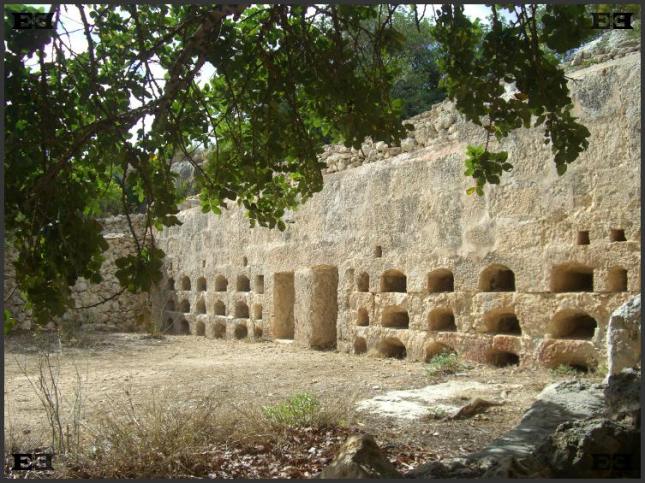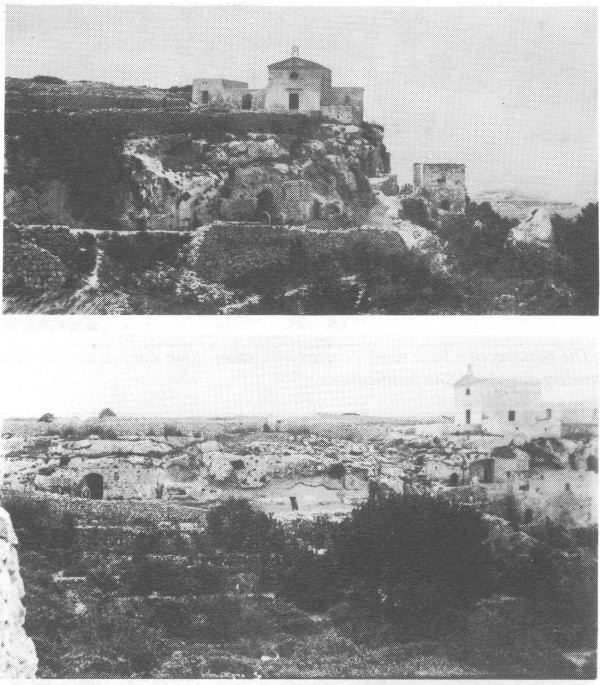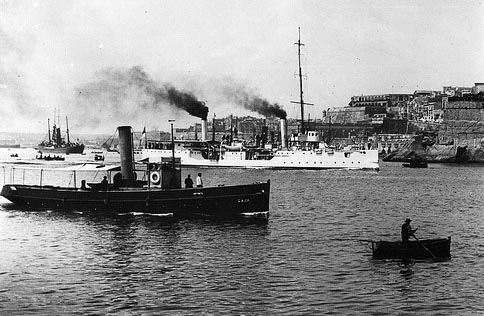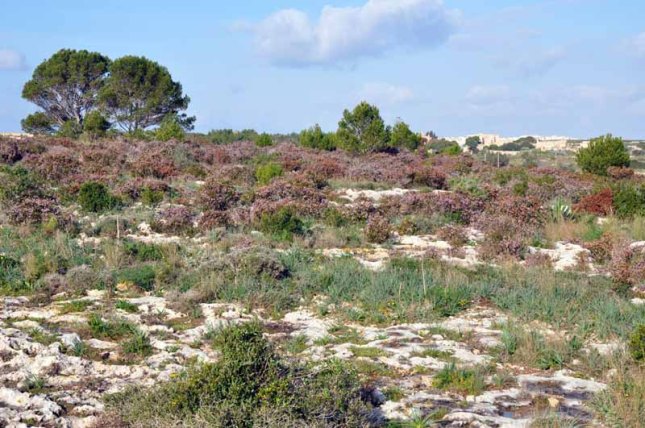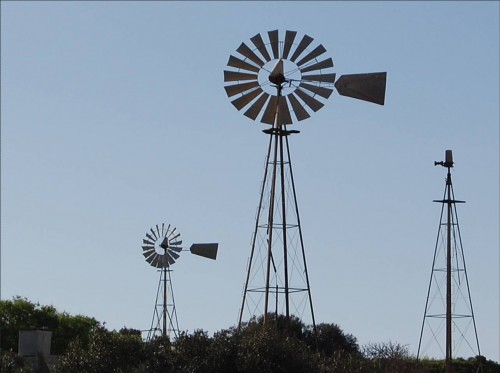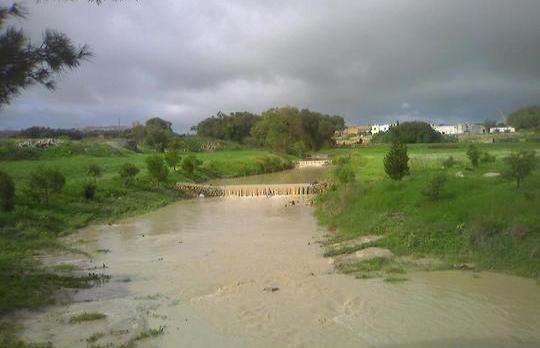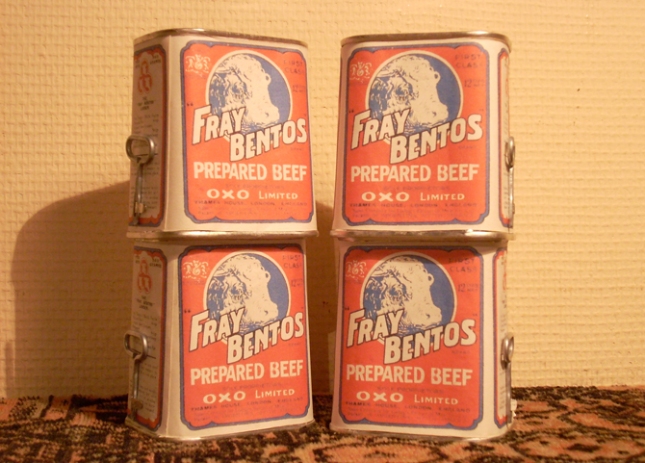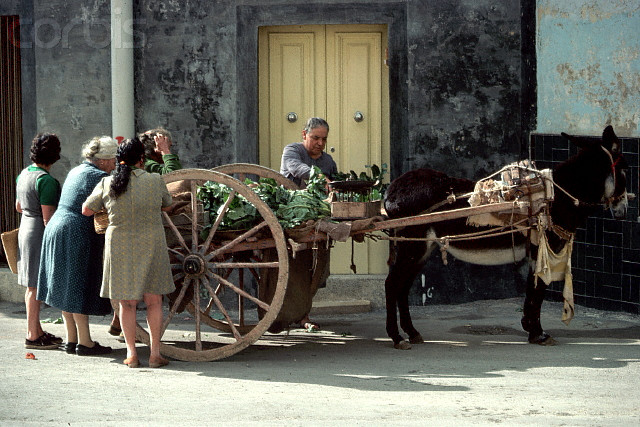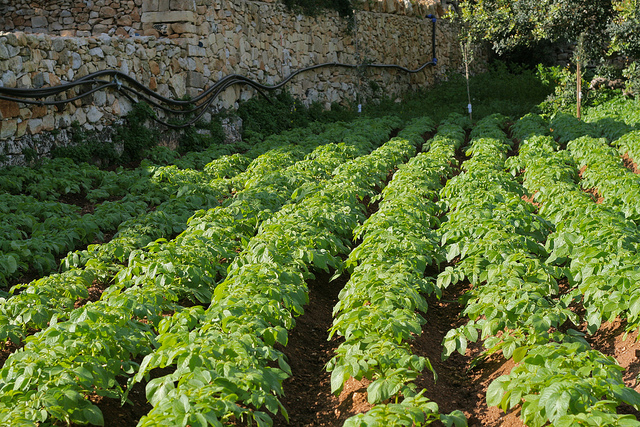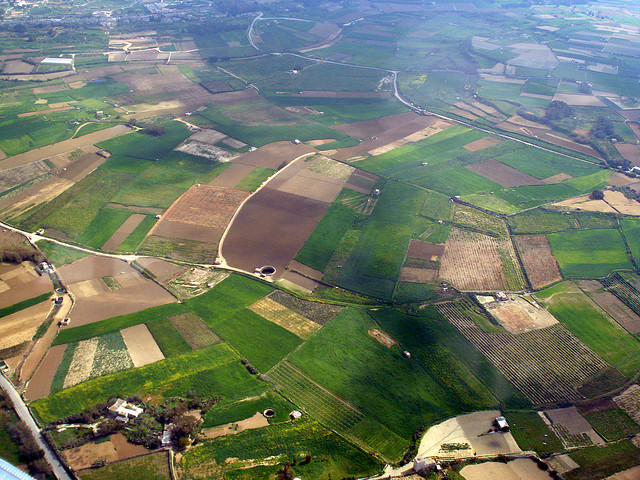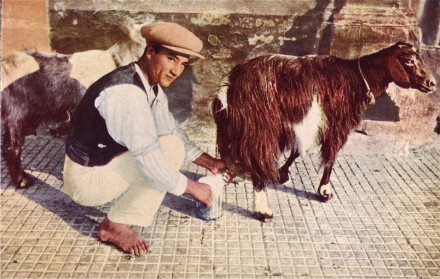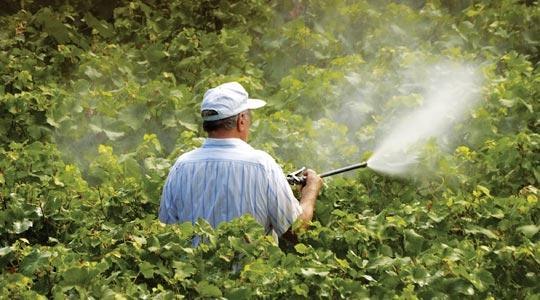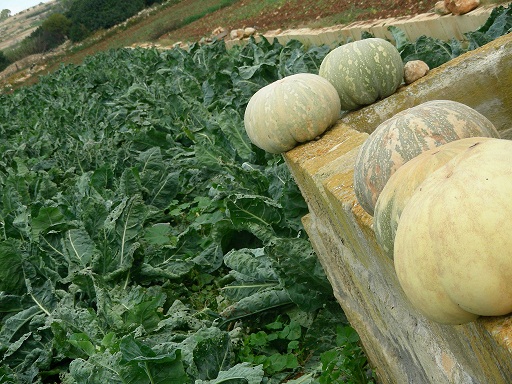Agriculture in Malta
I. – Introduction
The origins of agriculture in Malta are as old as man’s presence on the archipelago. Judging by the quality, size and numbers of the megalithic temples on the islands, those origins are indeed remote. Tools and agricultural equipment discovered in Malta express neolithic man’s vocation to husbandry and his dedication to agricultural life.
That the Maltese were advanced in their knowledge of agricultural science and of related pursuits has been well documented. Roman historians refer to the islanders’ prowess in producing cotton and honey.
Sails manufactured in Malta were a prized possession in the ancient world. Honey is, of course, associated intimately with Malta’s own name.
Seafaring nations, and seafarers generally were, since antiquity, lured to Malta’s shores not only by thesheltering natural coves and harbours but also by the abundance of agricultural produce to replenish their stores. Ship chandlering in Malta has had, as a result, a long history which today is manifested in the overwhelming success enjoyed by the island’s Freeport inaugurated in 1991.
Agriculture did not make the Maltese farmer rich, but history recounts that the community was able to raise, in the fourteenth century, a king’s ransom in gold to free itself of the despotic fiefdom imposed by a medieval tyrant.
When the Knights of Malta sent out a reconnaissance mission to assess their eventual use of the island offered to them, for want of anything better, by Charles V, the commissioners reported on the bareness of the country, referring to the sparsity of vegetation, lack of water and climatic and topographic features not being too clement for crop production.
Nonetheless, even before the advent of the Knights in 1530, Malta was able to provide for the livelihood of its inhabitants not in luxury but certainly not in penury. The farming society of pre-Order Malta had been able to support important village clusters, many of which had churches and chapels adorned with valuable art and artefacts, including gold and silver articles of devotion and of religious embellishment.
Subsistence agriculture it may have been for the hamlet dwellers; but in the large villages the well-to-do farmer was not unknown.
With the appearance of the Order of St. John in Malta, new modes of production appeared, notably around the Grand Harbour area where the Knights, whose fleet was to obtain mastery of the Mediterranean, built and repaired their galleys.
In time, particularly after Malta’s absorption in the British Crown in 1814, most of the gainfully occupied population became active in secondary and tertiary production, and agriculture started to experience, from the mid-nineteenth century onwards, a relative but long decline.
The large farming-oriented villages hitherto the traditional backbone of Maltese society, such as Zebbug, Siggiewi, Zejtun and Zurrieq, saw their importance lost to the “newer” settlements such as Paola or to the “urban” areas near the Grand Harbour, on whose western shore nestled, since the mid-sixteenth century, the capital city of Valletta, usurping both Mdina, the old capital, and the Borgo (Vittoriosa), the Knights’ original administrative centre.
In the process, the behaviour of the Maltese economy became a function of the demand for Malta’s strategic position and allied tertiary production placed first by the Knights and then, right up to modern times, by the British.
Agriculture itself witnessed important transformations, the most notable being the radical change from predominantly subsistence to commercial farming. World War ll, with its imposed scarcity of supply of agriculture produce and the increased additional demand presented by the British forces in Malta and in the Mediterranean, brought the average Maltese farmer a measure of wealth which he had never before enjoyed.
By 1946, however, the onset of demobilisation in the aftermath of War, and its accompanying decline in jobs offered directly or through the multiplier effect by the British Services and related activities, generated a massive unemployment which the authorities felt could be alleviated, in the short-term, only by a massive programme of migration, mainly to Australia. In consequence, large numbers of young men from the farming areas sought greener pastures, in more ways than one, in Australia.
Because their departure had a lasting impact on Maltese agriculture, it is useful to dwell on the historical vicissitudes of agriculture in the postwar periods, focusing our attention on the 1946-1961 period, as they correspond, constitutionally to the phase of Self-Government (1946-1958), and the return to Colonial rule (1958-1961). A year later, Malta received again a limited form of self-government which led, in 1964, to Malta’s acquisition of Independence.
One important result of the situation referred to above is that income derived from agriculture in 1960 was practically the same as it was fourteen years earlier, even though the period 1945-47 was marked by abnormally low rainfall.
_________________________________________________
II. – The Agricultural Landscape
In 1946 as, with minor variations, in both 1938 and 1960, the area that could profitably be cultivated for agricultural purposes in the Maltese Islands consisted of about 45,000 acres of dry land and 2,000 acres of irrigated land. The total number of farm-holdings was about 14,500. Physical gradation in the Maltese landscape has always afforded an expression of socio-economic conditions. It has been noted that the Islands present a marked correspondence between the physiographic and the agricultural region and this serves as a useful indicator of agricultural economics in Malta. It is necessary, then, to give a brief description of the agricultural landscape.
1. Rdum and Gnien Areas
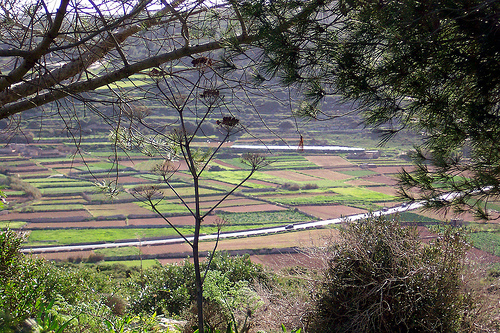 The farmers who live in the rdum and gnien (garden-type areas are those who have the highest incomes in the farming community; because here fruit is grown intensively and yields high profits.
The farmers who live in the rdum and gnien (garden-type areas are those who have the highest incomes in the farming community; because here fruit is grown intensively and yields high profits.
In the Western scarplands (Wied il-Pwales) farmers go in for vines, as do some on the neighbouring Wardija Uplands. Vines are also cultivated in areas of Wied il-Ghasel and in gnien embayments of the Bingemma basin.
The Western rdum lands are intensively cultivated; in some of the largest embayments, such as Gnejna, l-lmtahleb and Wied ir-Rum, specialized farming is carried out, while typical gnien crops are grown on the terrace-retained mixed soils of the narrow zone near Rdum ta’ Dingli. The extensive gnien belt of land watered by many rivulets and streams has made l-Imtahleb and Wied ir-Rum a major centre of fruit cultivation. In the Fiddien district of the Blue Clay Basin, drained by the upper Wied Qlejgha, fruit is grown among a lot of other agricultural produce.
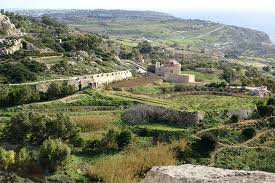 But intensive fruit cultivation is at its best in the spring-line zone Iying between the junction of Upper Coralline and Blue Clay along the eastern flanks of the Rabat-Dingli uplands stretching from Mtarfa to Tal-Bajjada. Siggiewi and Zebbug farmers, in particular, cultivate most of this land and their prosperity during the war years was well-known. At Girgenti and Wied ix-Xaghri, yields are high, and a profitable market is always at hand.
But intensive fruit cultivation is at its best in the spring-line zone Iying between the junction of Upper Coralline and Blue Clay along the eastern flanks of the Rabat-Dingli uplands stretching from Mtarfa to Tal-Bajjada. Siggiewi and Zebbug farmers, in particular, cultivate most of this land and their prosperity during the war years was well-known. At Girgenti and Wied ix-Xaghri, yields are high, and a profitable market is always at hand.
In Gozo, gnien farming is carried out in the Zebbug area of the Northern Region, and specialized fruit growing is centred to the east of Ghajnsielem.
2.The Xaghra Areas
At the other end of the scale, the xaghra (barren meadows) lands are only used, in parts, for the hardiest fodders and legumes; on some small expanses of soil, vetches and poor barley are cultivated. Much ofthis xaghra area, which includes a large part of the Marfa peninsula and the Ghallis Hills, the inaccessible parts of the Santi-Bingemma Uplands, the Upper Coralline plateau near Ghajn Qajjet, and areas of the Globigerina Naxxar – Gharghur hill lands, and, in Gozo, the coast-fringing wastelands in the West, and the xaghra areas of the Southern region, was controlled for military purposes during the war and for most of the 1946-62 period. Some of the soil-bearing areas amid the xaghra regions were out of bounds for the same reasons.
3.The Dry-Farming Areas
The greater part of the arable land of the Islands is given over to dry-farming, varying in crop-quality according to various exposures, slope and water supply. Where conditions are more favourable, medium-quality crops are grown; potatoes, as always, are the favourite. Vegetables are grown in abundance; and in the irrigated areas, the higher-value vegetable crops (including melons, tomatoes and artichokes) are widespread.
_________________________________________________
III. – Climatic Conditions
A lack of sufficient water has always been an obstacle to Maltese agriculture. But absolute rainfall figures do not by themselves reveal the variability of rain between one year and another, between different periods of the same year and, even though the Maltese land area is small, between one part of the Islands and another. These “regional” and temporal fluctuations have important economic effects. They are, for instance, essential to an understanding of the Maltese farmer’s unusual and often misguided zeal to obtain the highest yield, with consequent soil depletion because of his methods, due to climatic uncertainties.
Admittedly, the imponderables of the Maltese weather are not as great as in North Western Europe.
Thus in the 119 years between 1841 and 1959, there were only four months—November, December, January and March—that, on at least one occasion, have not had complete drought. July has had absolute drought 100 times in this 119-year period. Yet variations in annual rainfall are so great that even if we wanted to classify Maltese rainfall in terms of lateness or earliness, or of dryness and wetness, we would be obscuring rather than clarifying the picture.
However, following Mitchell and Dewdney (1961), one may say that on an average basis Malta’s rainy season is of two types:
i) a long, wet spell lasting two to three months, broken by short, dry spells (such as between 1927 and 1929);ii) short, wet spells with long, dry periods (such as in 1911-12, 1919-20 and 1945-47).
It must be added, however, that the Maltese farmer, whose ploughing and sowing take place in the winter months, is relatively fortunate in that rains in the Islands are consistently broken by periods of dry, sunny and warm weather.
We must now add a note on spatial variations. This is of particular interest because of the relatively high incidence of storm rainfall in Malta. One knows from direct experience that a continuous fall of 2 inches or more leads to extensive physical damage on the farms; on any day with 3 inches or more of rain, severe adverse effects may be taken for granted.
Barring the merit of removing accumulated salt from irrigated land, and of transporting soil from karstland to the terraces below, the effects of storm rainfall are ruinous for the vast majority of Maltese farmers.
Torrential rain damages crops by direct impact, leads masses of clay to slide downhill and severely weakens boundary walls. Little streams are formed, eroding the soil in their wake, destroying small dams and uprooting growing plants. The position is worse in the low-lying areas and in the valleys where dams are silted up and flooding occurs in the more level lands. Sulla is usually one of the main victims here.
The damage is often more lasting than the above may imply, since the soils in these regions remain so wet as to prevent later ploughing, and hence no crops can be raised till the following winter.
In the flat lands, farmers lose their valuable late tomato crop and the potato crop sown in autumn.
Gullying inflicts heavy damage in these areas; gullies, up to 2 feet deep and equally wide, spread all over the fields, destroying plant life in their course. This explains the fact that farmers in the northwestern regions of the Islands—particularly the areas close to St. Paul’s Bay, Mellieha and Mgarr and the Rabat (Malta) region—are normally the worse hit, and the ones who (as in 1957) have to receive financial assistance from the Government if they are to survive after storm rainfall.
Rainfall conditions have their effects on husbandry as well. Due to the paradoxical nature of the Maltese climate in providing more moisture at a time when there is least demand for it, and virtually no natural moisture at all when the plant growth potential is at its highest, the management of crops follows three patterns:
(i) Rain-fed crops are either sown in the middle of the rainy season when soil moisture is at a maximum or before the onset of the autumn rains;(ii) Crops dependent on soil moisture are planted late in the rainy season since rainfall would not by itself be adequate for them;(iii) Three crops a year can be raised in irrigated areas if water can be brought from external sources to supplement the supplies of rainfall and of soil moisture.
However, though, under conditions prevailing in the Islands, rainfall is the most important climatic element in that its spatial and temporal distributions have a decisive effect on agriculture, yet the combinations of wind, temperature and humidity conditions taken together can also have an adverse effect on plant life. It is impossible to discuss them in detail here; but one may say that the Xlokk, the hot, humid wind that blows on 13% of the days of an average year, and the cool, northwesterly Majjistral (on 29% of the days of an average year) exercise a considerable influence on transpiration rates and on wilting points.
It appears that the Maltese farmer has in the course of centuries adjusted himself to average seasons.
_________________________________________________
IV. – Production
The contraction of local output, due in part to lack of manpower and in part to the non-utilisation of fertilizers, coupled with the cessation of imports during the war years led to the prevalence of astronomically high prices for agricultural produce between 1940 and the earlier part of 1943. By the end of 1943, war had virtually receded from the shores of the Islands and agriculture showed signs of improvement. Demobilised men began to return to the farms, output started to increase and prices began to fall.
The latter event, accelerated by the supply of imported substitutes had, particularly between 1943 and 1946, an adverse effect on the price elasticity of supply. The older farmer who had thrived on produce scarcity had saved enough to last him for many years to come, and was not particularly concerned at carrying on a more intensive cultivation to offset the lower price levels; the younger generation of farmers became increasingly attracted to town-life. The succeeding years were to witness a decline in both the average area of individual farmholdings and in the total area under cultivation.
The only agricultural produce, besides vegetables, that recorded an increase in acreage under cultivation, consisted of vetches and grapes. The former’s acreage was 1,943 acres over the 1938/39 figure, that for the latter was 420. Efforts to expand the wine industry may have been an incentive towards greater grape production. But in most other sectors, the performance of agriculture was poor.
Vegetables, as we have noted, had risen over the 1938/39 figures; but had rainfall been more abundant, crop production could certainly have done better. The 1946/47 figure was well below the wartime peak of 445,000 cwts, achieved in 1944/45.
A different picture emerges in the prices of agricultural produce. While the 1946/47 acreage was 21% lower than that for 1938/39, the total value of the crops for the former year was some 157% greater than that for the latter.
From the growth rate aspect, then, while the 1946/47 value of agricultural produce was 157% greater than that for 1938/39 in real value terms, the 1946/47 figure was only 58% that for the former year.
We have remarked earlier that the causes of this decline included the change-over from war to peacetime living conditions. The re-opening of trade with foreign countries had a large impact on this matter. It brought about certain advantages, but from a strictly economic aspect it was an adverse factor, in the Island’s development; the unfavourable balance of trade worsened.
Between 1946 and 1958, in particular, the availability of imports and of substitutes kept local prices down. Dietary changes, though small, had their share in this change. Higher wages and salaries affected the income elasticity of demand. A relatively lower consumption of food was obtained during the last years while, as living standards rose, expenditure on household durables increased.
Government policy in the 1955-58 period started reaping its fruits between 1959 and 1961, partly under the influence of the Development Plan. A feature of this change would be a lesser reliance on imports.
The decline in imports witnessed around 1959/60 pointed more to a gradual change in favour of local products in the range of consumer preferences rather than to a real spectacular lessening of the need for imports. The consumption pattern which emerged in the late fifties, one based on local produce, created a basis of sectoral inflation. Its appearance was noticed in early 1960, with a constant rise of agricultural prices. It so happened that this was accompanied by a small rise in quality, due in part to better husbandry conditions, in their turn attributable to Government intervention.
Compared to other sectors, however, agricultural output lagged far behind, and most of the period suffered a succession of reversals. It was only from the mid-fifties onwards that one noticed a trace of general improvement. But the lack of sufficient incentives on the farms still accounted for a relatively low output.
The price structure of vegetables has always been of special significance in the Maltese cost-of-living pattern due to their traditional position in the local diet particularly in the rural areas. The dependence on local produce during the War increased their demand all over the Islands, and measures for price control had to be enforced, the Government awarding contracts for the total supply of certain crops.
Black market activities in this sector were widespread during the war and the Cost-of-Living Conference in 1944 stated that the only solution to reduce the prevailing high prices was through decontrolling and derationing. The problems involved were unusually complex, but the more salient features of the situation in the years 1944/46 were the following:
1. The demand for imported food products, which one noticed during the War years, did not apply to vegetables. Tinned products substituted several of the more highly priced local products, but there were no tinned vegetables beyond, perhaps, peas and beans which, in any case, never formed a predominant part of the local diet.2. The commercial farmer had already reaped the War harvest in 1944. If heavy restrictions were placed on the sale of his produce by way of controlling his prices, he could simply carry on as before without bothering to increase the acreage under cultivation. The same thing would happen if a price de-control actually lowered prices, the long-term effect being, in view of the inelasticity of the demand, a real rise in prices.3. The acuteness of the dilemma outlined in the above paragraph rendered itself particularly sharp to the Cost-of-Living Conference because either way it was the working-class sector, representing the vast majority of the islanders, that tended to suffer most by high vegetable prices due to the high vegetable percentage in the local diet.4 . Difficulties in controlling the Pitkali (market wholesalers) were in some instances overwhelming. Fraudulent packing or weighing was high among them, but the outstanding difficulty was the Pitkali institution itself insofar as it occupied a central place in the vegetable market.5. Costs of production were particularly elusive of computation. Most of the farms were family concerns, the labourers being virtually always members of the family. Outside help in the sector was difficult to come by. The farmer himself was not so much reluctant to divulge his costs of production as much as he was genuinely ignorant, by and large, of what they really were.6. The difference in soil and the resultant variety of fertility gave rise to qualitative price levels that, in a small area, were not easy to handle. Other factors affecting the price situation were fluctuations in rainfall, differences in the rotation system between one field and another and distances from the market.
It might appear that a major incentive for higher productivity could have been a provision for the farmer’s direct access to the consumer, or at least to the retailer, by-passing the Pitkali. But though this should have seemed the logical thing to do, it would have had little success with the Maltese farmer. Maltese agricultural authorities realised that it was not easy to convince the farmer that he would be better off if he were to have direct access to the consumer market. The difficulty lay, more than anything else, in the Maltese farmer’s outlook. Education could help but could not radically change the peasant’s simple life, his love for the quiet country life, away from the vicissitudes of market life. Providence had helped him during the war years to make some profits; now that wartime conditions were over, he was happy in the reminiscence of the past. He did not care very much for the refinements of marketing techniques. The same attitude applied to modern agricultural methods.
The Pitkali could not be happier with this state of events. As agricultural agents, they ran no risks comparable to either the producer’s or the retailer’s; and though many farmers treated them with suspicion during the war years, yet they knew they could not easily be uprooted from the marketing structure.
No major changes in the Pitkal-farmer relationship were noticeable between 1946 and 1960. True, the Pitkal lost some of his power; but the institution survived largely intact. The growing decline in output continued to benefit him, and the consequent rise in the value of produce—particularly tomatoes—if anything, strengthened his position. That the Pitkal’s dominance of the market did not victimize the consumer even further was mainly due to Government supervision in attempting to keep inflationary prices at bay.
There was, however, a fresh development, particularly noticeable since 1950, and gaining momentum since 1956 when special provisions were made to give financial assistance to farmers, through grants and loans for investment. There was a gradual appearance of solidarity among the farming community.
Meanwhile, the new cooperative movement, even though it still had a substantial amount of ground to cover, had through its incipient success, confirmed the wisdom of its application to the Islands.
During this period, it became apparent that, in the context of Maltese agriculture, if the farmer was given greater security, he would find some incentive to increase his output. It was, then, the long-run perspective and the potentialities it afforded for a growing output that ultimately made one regard the development of the farming community as a strong and independent entity, a desideratum of considerable scope.
Spring potatoes deserve a note on their own being Malta’s principal agricultural export. In effect potatoes have always been an indicator of the agricultural market. The yield per acre fluctuated considerably during the War years, reaching its peak in 1941/42, when the demand for local produce was at its highest. Fairly good rainfall during that year was an added favourable factor. The yield went down towards 1946/47, when the acreage was increased. Excluding the crisis years 1940 to 1943, the acreage did not suffer great changes, which may indicate a measure of stability in the consumption pattern.
But this is only part of the story. For even if home demand was fairly inelastic, yet foreign demand for spring potatoes was always in excess of the limited Maltese supply. The export success of the spring crop depends on its early availability. The warmer Mediterranean climate enables the spring potato to be planted in December or early January and lifted towards late March, thus giving it an average two-month priority over Northern Europe. Hazards afflict the crop, and it is difficult to forecast the year’s yield.
Weather excesses, either in the form of relative winter rainfall deficiency, or ground frosts in January or even, cool and humid spells in February, may bring havoc on the crop. It was, in fact, the drought of the years 1945/47 that decreased the yield and gave the farmer a rough time. The loss of the spring crop, in 1951, soon after sowing, led to a similar situation the following year.
Due to the necessity of putting the crop on the market as soon as possible, potatoes are grown in areas either close to the villages or otherwise easily accessible to the towns. On the east and south regions of Malta, where villages and casals are clustered together, the potato is easily the most predominant crop cultivated. To the west and north, concentrations are smaller with the notable exceptions of the fertile Wied il-Pwales and the areas around Mellieha and Marfa. Distance from Malta’s harbours put Gozo virtually out of the potato export picture, and in the sister Island early potato cultivation is consequently of lesser importance; but there, too, potato cultivation is centred around the villages.
Loss of the export market during the war years led to a greater concentration on the winter and summer crop and it made the farmer cultivate less land. Moreover, profits on the potato home market were relatively smaller than in the vegetable market primarily because the profit margins allowed were smaller as shrinkage was far less than with vegetables. The Pitkal could always adduce this reason to make the producer accept a smaller sum enabling the Pitkal to register about the same profit as on vegetables.
The greengrocer’s margin was again lower than that for vegetables, lower shrinkage being again the official reason. But the surplus of potatoes during the war years was also an important factor; they were easier to obtain and made good substitutes for some vegetables. In an effort to create an artificial scarcity for their product, it was not unknown for farmers to stock their produce (which the relative imperishability of the crop allowed them to do) till demand could meet higher prices. Often, however, the Pitkal would fool the farmer by adopting the hoarding practice himself.
This situation was not very widespread during the war years as the greater part of the population lived in the villages. Concentrated urban areas like Valletta, Floriana and the Three Cities lost a good number of people who flocked for refuge to the villages or who, rendered homeless by enemy action, sought a house or a relative’s hospitality in a rural area. The nearness of the sources of produce enabled the average consumer to get his potatoes at fairly reasonable prices; the P i t k a l had less opportunity to intervene, and the possibility of quick returns for his labours often persuaded the farmer to part with his produce on the farm, even though he ran the risk of prosecution since produce had to go through official channels.
The 1946/47 year entailed special difficulties in that the reopening of the market coincided with low rainfall and low yields. The home market met the situation by relying more on imported foodstuffs than on the expensive local produce in the measure that vegetable and potato price elasticities allowed. Scarcity and high prices during the war years had attuned the Maltese consumer to the value of tinned produce, even though he had not initially taken to them wholeheartedly. An important consequence of this was a change of diet, potatoes bearing the brunt of the unfavourable burden. Prospects of exports tended in this way to assume great significance for the potato merchant.
For it was the potato merchant and the broker who really had every advantage to reap from the export market. Not that this did not benefit the Maltese balance of payments; but the special conditions of the export market enabled them to make extra profits at the expense of the producer. The middleman found the complicated marketing position at the end of World War II very much to his favour. He knew that the farmer, out in the quiet and isolation of his fields, had no knowledge of export prices. Illiterate and uncultured, the farmer could be made to believe almost anything; confronted by the middleman’s take-itor-leave-it attitude he had no choice but to bow to the prices offered. This was especially true in the years 1945 to 1950.
Unfortunately, the farmer’s fear of the middleman extended to Government, the only institution from which he might have expected some help in his marketing difficulties. He had some cause for this fear, especially because of reprisals for black market and similar activities during the war years. At the same time, it is only fair to state that successive Governments had not done much to better his lot or to protect him from the wiles of the middlemen.
If the farmer could not be educated to realise how matters stood and thus enabled to make his own market assessments and to arrive at his own decisions, he would always be in an inferior bargaining position with the Pitkal and the broker.
What characterised the 1946-62 period was the weapon the farmer often employed to safeguard his interests: the hoarding of the potato crop. He hoped in this way to stimulate false market conditions, and to obtain better prices from the middlemen. This was a major factor of price instability and Government itself was at times perplexed at the scarcity of supply after a good harvest.
_________________________________________________
V. – Finance and Ownership
1. Finance
In his report on cooperatives, Paris (1945), recognised that one of the essential elements for the improvement of Maltese agriculture was the creation of the possibility for the farmer to have short-term loans to provide him with working capital for the purchase of such items as seed and fertilizers. An Agricultural Bank in a Maltese context would have been unsuitable. Most of the farmers had little capital to put into such a bank; what capital they had accumulated during the war they preferred to keep either at home or else, when education spread more among them, at the Government’s Savings Bank.
The only field where such a bank could have been useful would have been in the granting of long-term credit to tenant farmers for the purchase of their land. But this was a rather restricted sector for four main reasons:
(i) the tenant farmer did not always see the utility of owning his land; normally his rent was quite low and few were ready to part with capital, even on a long-term basis, when they did not think it made a material difference to their way of life;
(ii) land owned by private people was not always easy to buy, because (a) at the end of the war, rumours about various development schemes made the land-owner cautious to sell his land in case it was close to or part of a development area, when its value would be multipled; (b) if it was not, the average nonpeasant landowner would see no harm in keeping his land even if it was giving him a return of a few pounds per annum;
(iii) land owned by the Church or Church fraternities or organisations could not come to the market except by devious ways. There were a number of difficulties, some bureaucratic, some legal, some financial;
(iv) land owned by Government or the British Services was not likely to change hands. The former was more interested in acquiring land than in selling it, and the latter, at least up to 1947, were still interested enough in Malta to retain their lands.
Such a restricted sector could not have warranted the setting up of an Agricultural Bank. What the farming community actually needed were short-term loans, which could be provided by a cooperative credit society working in the villages, with a main office in Valletta. However, the average farmer did not himself appreciate the need for such an institution in the immediate postwar period. What he wanted most of all was not credit for the war boom was still recent; rather he required more protection from the Pitkal. It was to this form of co-operation that the farmer might have been expected to respond.
2. Ownership
It is useful at this stage to study more closely the farm ownership situation that prevailed till recent years. The period 1940-47 saw a continuation of the century-long reduction in total acreage under cultivation.
Between 1947 and 1957, the net balance showed an almost static position; after 1957, it started to decrease. To the several factors responsible for these events pointed out in the preceding pages, we must now add land ownership. Here again, the main changes took place before 1947.
Farmland ownership fell into several categories:
A. Civil Government and War Department Ownership
These types of ownership have to be tackled together partly because figures up to 1945 are given together for both sectors and partly because they portray the same characteristics.
On a long-term basis, the cultivated land owned by both these parties did not undergo relevant changes during the half-century or so preceding Self-Government in 1947. There was a slight increase between 1944 and 1947 when reconstruction and development schemes necessitated Government acquisition of freehold land. These increases in “official” ownership were more marked in the sectors of uncultivated land than in the cultivated areas. A large part of the State-owned agricultural land had been given to the farmers on emphyteutical lease, a process accentuated from 1850 onwards. Such a lease, often limited to small areas of about 16 tmiem, was normally given on a 99-year basis, giving the tenant, subject to improvement of the land, a tenure of his fields which could be renewed by his heirs on a preferential basis. Rents were sometimes fixed at 1 1/2 d. per tomna.
A number of leases, particularly on settlement fringes, dry regions, or in the remoter areas was either completely abandoned or else hardly improved upon. Emphyteutical lease still was an integral part of the land ownership structure, but some farmers who had money to spare in 1945-47, showed some interest in acquiring freehold property from the Government. These, however, were by far a minority, for the length of emphyteutical leases and their low rents were quite advantageous.
B. Church-Owned Land
Church ownership of land could not increase at the same rate it had tended to follow before Government restrictions were imposed. Between 1891 and 1901, Church ownership of cultivated land had gone up from 16.5% to 17.1%, whereas the increase for the whole period between 1901 and 1945 was just 1.4%.
Emphyteutical lease was again common in this sector; some leases have been of so long duration that some farmers do not really know whether their land is freehold or emphyteutical. It could sometimes be very difficult to determine the exact ownership of a piece of land in what are traditionally held to be Church estates because records have not always been accurate. One major effect of the high incidence of this form of lease was that the farmer could not be persuaded to set up reasonably good dwellings on land he did not own. Technically, what improvements were made on the land would accrue to the owner on the expiry of the lease. Such farmers who knew of this stipulation, and one has reason to believe they were the majority, were not ready to erect lasting farm-dwellings on such sites, and the same difficulty applied to expensive irrigation schemes requiring individual financing. Given the nature of the lease and, particularly, the power it conveyed on the farmer’s heirs to have a continuation of the lease on preferential terms, this caution was rather difficult to understand unless one bears in mind the parsimonious habits of the Maltese farmer.
Church-Owned land was passed on to the Government in 1995 and is controlled by a Joint Office.
C. Private Ownership
The greater part of the agricultural land of the Maltese Islands is privately-owned. The exigencies of war required more land for state purposes, with the result that some land changed hands from private to public ownership. But the real reason which explains the long-term decline in private ownership of agricultural land is the substantial increase in building sites especially in the emerging towns and villages. This factor was particularly evident in the postwar period when that part of the population which had lived in narrow quarters during the War now looked for new homes. Again, married couples during the War had tended, because of the acute housing shortage, to live in their parents’ house or with relatives. Now they wanted a home of their own, and the pressure on land for building purposes was extraordinary. This tendency was accentuated when formerly demolished sites were rebuilt, and it became obvious that new houses could be built only on new land.
Types of ownership in this sector were more varied than in the previous ones. It was sometimes emphyteutical, sometimes on normal rent. Again, much depended on the location of the land. If it were in a remote area, it would be quite possible that the landowner himself would hardly know of its
whereabouts.
whereabouts.
D. Freehold Farmer-Owned Land
It is very difficult to give even a close estimate of freehold farmer-owned land before 1945 for reasons we have enumerated earlier. To speculate on whether such ownership had increased or decreased by then would be mainly guesswork. Caruana and Mizzi tried to show in 1947 that the area had increased, but this is open to dispute. They appear to have excluded from their considerations the fairly large number of farmers who say their land is freehold when in effect it has been on long emphyteutical lease.
Mitchell’s comments on this point are on the whole valid. Referring to the economic situation prevailing before World War ll, he highlights that the aging farmer would retain legal ownership until he was incapable of working it, at which time ownership would change. Since 1947 the existence of savings amassed during the price boom of World War ll and the granting of old-age pensions have together encouraged the farmer to retire at an earlier age from active management and through various crop sharing agreements to divide the usufruct with heirs, relations and friends. New types of tenures ensuring security to the original owner and opportunity to others are of considerable significance.
The argument that the grant of old-age pensions may have changed the position after 1947 is weak for most farmers would not qualify for them. In the absence of accurate figures for the increase or decrease of freehold farmer-owned land, we may perhaps assume that the general trend of a decrease in the acreage under cultivation and the increase in building may, in the long run, have actually reduced the freehold farmer-owned area.
In itself, however, the question of land ownership was not of vital importance to Maltese agriculture.
To say that freehold ownership should have been encouraged because it was conducive to better productivity is an over-simplification that can be misleading. In view of what has been said earlier, the farmer would normally try to get the best out of his land as long as he needed to do so and, especially, as long as the land was capable of giving him what he wanted, regardless of whether he owned it or not.
The latter condition was, in fact, the determining factor in a farmer’s wish to buy the land he occupied: if it was fertile and, particularly, if it was well-irrigated, he would be much more prone to have it for himself and for his heirs than if it were far from water sources.
_________________________________________________
Vl. – Husbandry
1. Farming Husbandry
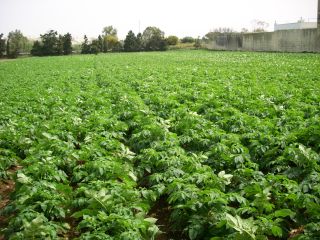 The Maltese Islands provided, during these years, some glaring contrasts in arable farming husbandry; a complex of traditional care and knowledge handed from one generation to another, a growing, if small, sector where new techniques are applied, and instances of sheer land neglect. On the one hand, one observed careful tillage sequences: a first shallow ploughing or howing to kill weeds, a second deeper ploughing one week later to break up the surface crust and ‘stir’ for aeration of the soil to a depth of some 6 to 9 inches, and a further ploughing just before sowing to produce a fine surface tilth. Hoeing and ploughing occur in periods of high wind during which steady and large-scale wind removal of the finer aggregates takes place. Similarly, single trees can be almost coddled, while orchards are most often neglected and, while village refuse and animal dung are carefully worked into the soil, little effort is made to discard inorganic rubbish or disease and seeding crops and weeds.
The Maltese Islands provided, during these years, some glaring contrasts in arable farming husbandry; a complex of traditional care and knowledge handed from one generation to another, a growing, if small, sector where new techniques are applied, and instances of sheer land neglect. On the one hand, one observed careful tillage sequences: a first shallow ploughing or howing to kill weeds, a second deeper ploughing one week later to break up the surface crust and ‘stir’ for aeration of the soil to a depth of some 6 to 9 inches, and a further ploughing just before sowing to produce a fine surface tilth. Hoeing and ploughing occur in periods of high wind during which steady and large-scale wind removal of the finer aggregates takes place. Similarly, single trees can be almost coddled, while orchards are most often neglected and, while village refuse and animal dung are carefully worked into the soil, little effort is made to discard inorganic rubbish or disease and seeding crops and weeds.
The country roads of Malta were, unfortunately, permanently lined with rubbish. Weeds and pests flourish everywhere. Broomrape, an indigenous field weed, deprives crops of precious water and plant nutrients on the thin, dry soils of the dry farming regions. Oxalis cernua is present in many cases. It was easy to talk of controlling these menaces, but the real difficulty was how to convince the farmer whose deeprooted convictions offer an obstacle to the progress of husbandry. The same mentality accounted for the prevalence of pests and plant disease.
There were, however, wider and even more serious aspects of the husbandry situation. If Malta was to export agricultural produce, the export product had to be of a high quality and free from disease, a condition that was perhaps most apparent in the highly competitive spring potato export market.
Increasing farmer education during the latter part of this period went towards the development of a better soil and healthier crops. Scientific study and examination provided, however, only the groundwork, and the results of this research could be appreciated only if the Maltese farmer had had the specialised knowledge required to follow an enlightened husbandry policy. He had yet to realise that high-grade farming would pay dividends.
The farmer was taught and lectured to, but he would not take action unless he was positively convinced that new methods were more financially rewarding. Conservatism, fear of risks and shyness of neighbouring farmers played an important role here, particularly in view of the high percentage of older farmers. As Bowen Jones H. et al., op. cit., 1961, have noted, this cautious attitude was evident in the use of fertilizers. One farmer would break the ice and introduce a new type of manure. More often than not, he had no real idea of the scientific worth of his fertilizer; but, having overcome the initial fear, he would now feel he had a social lead over his neighbours. The latter would then introduce the same fertilizer to their fields, and, even though results would lead only to an increased production of foliage rather than of carbohydrates in the tubers (as in the potato crop) yet they would feel they had accomplished some progress. To enlighten them about a possible failure or to show them the superior merits of another fertilizer was a task requiring patience and the passage of time.
As agricultural imports grew, it was nitrogenous fertilizers that dominated. Under Maltese climatic conditions, the mere usage of nitrates was most probably harmful rather than beneficial to crops, particularly in the context of low potassic content in Maltese soil. Given the social background of the Maltese farmer, a very great effort had to be made to remedy this ill.
2. Livestock and Animal Husbandry
As most Maltese farmers are, in varying degrees, livestock breeders, it seems logical to refer to them when discussing agriculture. We shall first analyse the relationship between cows and goats in the case of milk production and subsequently poultry and rabbits.
A. Goats and Cows and the Supply of Milk
The indigenous Maltese goat supplied the islanders with most of their milk up to the beginning of the 20th century. Cross-breeding with the British Saanen-type resulted in the gradual disappearance of the original Maltese stock, and the outcome was a hardy and prolific milker. The number of goats on the islands was fairly constant between 1934 and 1938, but in the following year it leaped by 6,288 to 41,758. Feeding difficulties reduced this growth during the war years, but a 25% increase was registered by 1945, and a further 20% increase during the following year. A small reversal took place in 1947, but the number was up to the 1946 record a year later. After that, decline was rapid and the goat population stood at 34,688 in 1960.
Increases in forage costs and the greater availability of cows’ milk were mainly responsible for this decline. Another factor was the shortage of grazing-land and the regulations governing goats’ milk supply. Wasteland had always provided a natural pasture for goats; but as its area contracted, the herdsman had to shift to fieldgrown forages, which was a limited source. At the same time, the Milk Marketing Undertaking (MMU) theoretically bought and processed all local milk supplies. Up to the late forties, the herdsman would take his flock round the village streets where he would milk the goat at one’s doorstep. The presence of Brucellosis Melitensis in about 20% of Maltese goats necessitated obligatory pasteurization in an effort to wipe out undulant fever, the Maltese disease that was particularly rampant during and after the War years.
Two considerations have to be made here. In the first place, villagers still preferred to have their milk directly from the goat, so that an illegal trade in goats’ milk was still carried on. This preference, however, was not limited to the village, for the average Maltese still appeared to favour pasteurized goats’ milk to cows’ milk, though there were signs that this preference was declining. One explanation for the latter eventuality has been the free distribution of milk in Government schools; the psychological impact of something distributed freely, added to the social element in group consumption may have nullified, in the child’s mind, the distinction between the two types of milk.
In the second place, the extinction of Brucellosis Melitensis was not an easy task. The conditions under which the Maltese peasant farmer had to carry on his trade in Malta were not conducive to hygiene. As experience showed, Government imposition to control his animal husbandry could have led him to reduce the breeding of goats; and, consequently, would have given rise to hardship on the farms.
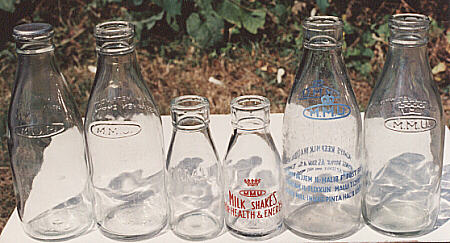 The supply and marketing of goats’ milk were a very complex affair. Several improvements were made over the period. In an effort to lessen the reliance on goats, a system was adopted in 1956 by which herdsmen could get one Dutch Friesian heifer in calf in exchange for twelve diseased goats. But, given the background or preference for goats’ milk, the substitution of the cow for the goat on a universal scale was somewhat impractical. Moreover, the Dutch Friesian is a pedigree animal, and requires trained management if pedigree standards were to be maintained. It was debatable whether the Maltese farmer could acquire the skill and the facilities to breed it on good standards.
The supply and marketing of goats’ milk were a very complex affair. Several improvements were made over the period. In an effort to lessen the reliance on goats, a system was adopted in 1956 by which herdsmen could get one Dutch Friesian heifer in calf in exchange for twelve diseased goats. But, given the background or preference for goats’ milk, the substitution of the cow for the goat on a universal scale was somewhat impractical. Moreover, the Dutch Friesian is a pedigree animal, and requires trained management if pedigree standards were to be maintained. It was debatable whether the Maltese farmer could acquire the skill and the facilities to breed it on good standards.
Social and political considerations were also vital factors governing this situation. The Government could not sacrifice the goat-breeder to minimise its own losses. Neither could it sacrifice the interests of the consumer in a matter so closely affecting the vitality and health of the nation. A greater impetus in cooperative production and marketing was really the only practical answer to the manifold problems of the milk supply. If some coordinated policy of production could have been worked out, then perhaps, it would not have been too difficult to ease out fluctuations among milk producers as a whole. A good marketing system would have had to be developed, channelling the produce direct to the consumer through the producers’ own organization. The MMU, which was doing excellent essential work, could not, of course, have been eliminated from the scene. But, on the hypothesis that a central production system coupled with a central marketing channel should have resulted in equilibrium in the milk economy, then the Government’s real concern would have been the surveillance of the pasteurization of goats’ milk.
But in postulating the above, it is acceptable that one would be basing on a set of suppositions that could take place only through severe changes in the social structure of Maltese animal husbandry.
B. Poultry and rabbits
In the special circumstances of Malta, the evolution of the production of eggs, poultry and rabbits, merits comment.
Poultry and rabbits form a large part of the Islands’ food supplies, particularly in the rural areas. A good number of farmers and many rural inhabitants rear their own hens and rabbits, and an immeasurable amount of small trade takes place in the private sale of poultry, poultry produce and rabbits between non-commercial breeders and consumers. Unfortunately, no statistics exist for Maltese poultry and rabbits up to 1954. The total number of poultry in the Maltese Islands then stood at 270,000, of which 57 % were in Malta and the rest in Gozo. The latter island has, in fact, been the traditional home of poultry, and exports a large percentage of its produce to the main Island.
There was a slump in the number of poultry between 1956 and 1957, more noticeable in Gozo than in Malta. The Suez crisis had again increased demand and the Gozitan breeder made more of his supply available. By 1960, the poultry population had reverted to its average and was pointing to a steady, if gradual, increase. The Rhode Island hen had now assumed a large measure of popularity on the Island, and the Government Farm at Ghammieri sold day-old cocks at about 9d. and day-old hens at about Is. 3d. At the same time, Rhode Island chickens, imported particularly from Holland, were put on sale by private importers at prices averaging 3s. 6d.
Eggs and their market constituted an important sector in local food consumption. Before World War ll, Egypt supplied Malta with much of the eggs not covered by the local supply. Between 1941 and 1943, the shortage of chicken food and of food in general led to abnormal slaughterings of poultry.
The closure of the foreign supply and the lessening of the number of hens boosted egg prices to astronomical heights, sometimes in excess of thirty shillings (30s.) per dozen.
To meet this situation, Government rationed imported egg powder but this substitute was not popular.
The official maximum price for an egg was 6d. but very few were obtainable at that price. When imports started coming in once more, prices began to decrease. For most of the 1950-60 decade, prices fluctuated around the 4s. 6d. level.
The consumption of eggs had meanwhile risen considerably, in part a reflection of the adoption of the British diet, particularly for breakfast. In 1960, in addition to the local produce of 2,202,933 dozen eggs valued at £367,000, some 2,094,153 dozen, valued at £308,860, had to be imported. Malta thus had to import 49% of the supply of eggs it required. Maltese production was increasing, but the rate of growth was not enough to meet local demand. The vast bulk of production was conducted on a small sideline basis, with prices varying from one seller to another.
There was no doubt that the Islands could have done considerably more to raise their self-sufficiency in this sector, if more coordination were forthcoming. Indeed a situation was to develop, in the sixties, whereby breeders realising the profits possible through large-scale scientific breeding, eventually overproduced leading to depression in what had become a fully-fledged egg and poultry industry.
_________________________________________________
Vll. – The Farming Community and its Setting
It is a fact that the size of holdings has been diminishing during the last one hundred years, Gozitan farms becoming increasingly smaller than Maltese. The Maltese median figure in 1891 was 18 tmiem, that for Gozo 13 tmiem. Twenty-five years later the Gozitan median had shrunk to 8 tmiem.
In 1945, the size of holdings had shrunk so much that the median Maltese farm was smaller than the Gozitan farm at the turn of the century. In 1960, the majority of dry-land holdings was between 1 and 14 tmiem for both Malta and Gozo, i.e., 8,503 out of a total 11,669 holdings or 73%. In irrigated land, 1,738 out of a total of 1,773 holdings or 97% fell within the 1-14 tmiem range.
The growing smallness of farms is, of course, a major problem in the agricultural structure of the Maltese Islands. The fact that agricultural land was becoming increasingly cut up into smaller portions and among a larger number of people was a formidable obstacle to cooperation in marketing and production. While the area under cultivation may not have suffered appreciable reversals in the 1946-60 period, the number of full-time farmers was decreasing; and it is not unreasonable to suggest that, in addition to the demographic, migratory and financial reasons pointed out earlier, one cause for this change is to be ascribed to this fragmentation process. As the farm grew smaller, the farmer got a smaller output and a lower income. To defend his position he had three ways open to him: to regard his farming as a part-time job; to increase his prices; or to merge with a fellow farmer or a relative. There is reason to conclude that the first way was more rapidly acceptable and more practical than the other two. An increase in prices was difficult for him to obtain in view of the marketing structure. On the other hand, mergers did not fall within the Maltese farmers’ social outlook. He preferred to run his farm on his own, and the younger farmer of the new generation was not deaf to the spirit of independence at large in modern society. From the farmers’ viewpoint part-time farming may have been the best solution; but to the national economy it would have been far more useful if the farmer had merged with one or more of his colleagues and worked the land on a cooperative basis. This solution, however, depended on changes in the social pattern and in the traditional ways of living of the Maltese.
The notable change that emerges from official data is that farmholders had increased, while farmworkers had decreased. And this is none other than a confirmation of the fragmentation process itself, and an indication that with the acquisition of wealth within the agricultural community, the tendency to derive income from land ownership rather than to be employed with a farmer had been increasing.
It was during the first half of this century that the big change from farmworkers to farmholders took place, but in 1946 there was still a good proportion of the former. The following two years witnessed a momentous upheaval in this sector, and by 1951 the number of full-time farmworkers had shrunk to under 500. Their number remained fairly constant hereafter. The total number of full-time farmers had been declining slowly, a process accentuated from 1946 onwards. Emigration was one of the main causes for this decline and its effect was strikingly apparent in 1954, when some 670 full-time farmers left the Island.
In the early Sixties, interesting elements in the age structure of the Maltese full-time farmers could be identified. lt is in the 15–19 age group that one found the largest number of farmers; the number was more than halved in the 20–24 age group, and went down further in the 25–29 group. A large concentration was to be found in the 50–54 group, and an even larger one in 60–64 group.
It would seem that in farmer-families, farming offered an initial source of employment to the younger members of the family. Two reasons can be adduced to explain this situation: the family structure was such that the head of the family normally expected his children growing into manhood to help him on the family holding; and, secondly, the difficulty of finding employment compelled the young man to take up farming until such time as he could find something better. The latter was an indication of the growing problem of unemployment in the Islands.
But the drop in numbers when the young farmer reached the age of 19 reflects the lack of attraction that agriculture displays. Social and economic elements account for this. The young man, eager to absorb urban ways, felt that a farming job was too lowly a status, an appraisal that was accentuated by comparing himself with his friends enjoying industrial or governmental employment. Financially, he realized the benefits of a more guaranteed return in comparison to his which, in the first place, could as often as not be negligible, the head of the family pocketing the bulk of the returns and secondly, projecting himself into the future, he became growingly aware that his eventual returns depended on the uncertainties of the elements. To render himself more independent of his family and more economically secure, he would normally try his hand at another job when and if it became available, failing which he would either return to the farm or emigrate.
From the age of 40 onwards, barring a small reversal in the 45–49 age group, the incidence of full-time farmers increased right up to the age of 64. It would seem that the sons of the farmer were likely to return to the fields when they acceded to the family holdings on the father’s death, a fact confirmed by the growing fragmentation process itself. In the older age-groups, returning migrants often accounted for the increase in numbers. An emigrant farmer who had done well in Australia or Canada returned to his homeland in later years and resumed farming on a piece of family holding which, in some cases, he had asked the other members of the family to reserve for him for just such an eventuality.
Housewives and houseworkers formed the bulk of female part-time farmers, but in all other occupation classifications of part-timers, men led the way. Workers in private industry were the most predominant occupational group because their conditions of work were such as to allow them, in a good number of cases, to take up part-time farming. The second largest male group was made up of persons employed in Government departments followed by own-account workers. There was also a good number of retired and incapacitated persons who still took to farming when they could or felt like it.
Taken as a whole, Maltese part-time farmers were an important group in the agricultural occupational structure and without their help output would have been considerably smaller. The role of housewives and houseworkers was particularly important as they took care of the fields and of the farm in general when the menfolk were away. In livestock farming, their contribution was essential both from the production and the marketing side. They often took care of the livestock, managing the feed and the breeding chores; and, as street-vendors, their presence was part of the national scene.
_________________________________________________
Vlll. – Conclusions in a Historical Perspective
The main conclusion one can draw is that Malta has not been historically making the optimum use of its agricultural and dairy resources. With regard to the latter, Government itself seemed to have regarded the dairy industry as desirable from a social standpoint, without taking adequate measures to ensure that it would be economically efficient.
Assuming that the growth of agricultural output was a major desideratum, one could say that the major difficulties hindering greater efficiency were the fragmentation process and the low level of education of Maltese farmers. In conjunction with and contributing to these factors were the paucity of workers and insufficient financial incentives as well as the uncertainties of the elements.
Only a reliable system of long-term forecasting seemed to offer any solution. The fragmentation process stemmed from legal foundations and hinged primarily on succession and secondarily on the relatively large farm-families. It is probably from this aspect, more than from any other, that an official agricultural economic policy would have been powerless. Fragmentation could be halted only through a system of land consolidation imposed by law and through the extension of cooperative agriculture to the production side or through the taking up of farming as a large-scale commercial investment.
The insufficiency of adequate financial returns was fundamental to the output problem of Maltese agriculture. Up to 1955, there was no coordinated Government policy on aid to agriculture. A Department for the sector existed, but it cannot be claimed that farming and dairying problems were treated with any efficiency. No definite aims were entertained, no sustained efforts to help farms to increase their output were made. This was due in part to a virtually complete absence of personnel with any specialised knowledge. The 1955 experiment, granting financial aid to farmers, was a major step forward.
Permeating all these difficulties was the somewhat overwhelming problem of the low educational level of the Maltese farmer. Depletion of the soil arose, apart from natural activity, through his misuse of fertilizers. His ignorance of production costs, his suspicion of modern techniques and, above all, his complacency over small returns made it difficult to apply concepts of opportunity costs and of the value of marginal product to Maltese agriculture. Yet since increases in output depend so much on the farmer’s ability and will to do so, Government had, if anything, to intensify its efforts at instructing him and at providing him with those financial and technical means necessary for improvement.
This was especially true of dairying. It is a fact that investment in this sector was increasing but output had not responded to higher investment levels. A main consideration here was the choice of techniques.
So complicated were the issues here that three independent authorities—a FAO team (1955), the Durham University Survey (see Bowen Jones, H., 1955) and the Animal Health Adviser to the Colonial Office (see Marshall, R. S., 1955)—reached quite different conclusions.
It has been contended that an enlightened land use policy should have been based on a foundation of livestock production to ensure provision of the protein-rich milk and meat. Moreover, fodder crops,
especially legumes like alfalfa and burseed, are thought to produce more income in milk per acre than vegetable crops. In this light, it would seem that the breeding of cattle on a large scale should have been a landmark of agricultural and dairying policy.
especially legumes like alfalfa and burseed, are thought to produce more income in milk per acre than vegetable crops. In this light, it would seem that the breeding of cattle on a large scale should have been a landmark of agricultural and dairying policy.
But apart from the fact that the Maltese farmer had only a vague knowledge of efficient breeding of cattle, the Durham Survey postulated that maximum returns from the utilisation of the land could be most suitably achieved by commercial specialisation in high value export rather than through livestock and crop production for the home market.
The view that lesser attention should be paid to crop produce for domestic consumption than for export may appear prima facie perplexing, since one knows that effective domestic demand was at a high level.
This demand had to be taken into consideration and, in long-term agricultural planning, due regard had to be given to the viability and resilience of farming in the short-term. However, what concerns us here is the optimum use of resources, particularly as this sector was the Islands’ most significant natural resource.
The criteria of optimum use must be related to the highest value of output obtainable. Now it is a fact that in the context of Maltese agriculture, output was not likely to increase unless the number of farmers and of farmworkers increased. The outlook of the Maltese farmer was such that, contrary to expectations, he was not likely to increase yields or acreage because of a lowering of the value of the marginal product.
His ignorance of production costs and his habit of responding to lower returns by rendering his life more austere are fundamental considerations here.
Only relatively high financial incentives would have attracted more labour into agriculture. But given the relative price inelasticity of local supply, in so far as the domestic market was concerned, such incentives towards higher agricultural output could only come from foreign markets. Bearing in mind Malta’s advantages in terms of climate (particularly for spring potatoes and tomatoes), it should have been seen even then that the optimum use of Malta’s agricultural resources lay in high-quality produce for export.
_________________________________________________
IX-AGRICULTURE NOW
Malta’s agricultural sector is small and only accounts for about 2.8 percent of GDP, but it is diverse. In 1999 only 5 percent of workers were employed in agriculture and there were only about 10 square kilometers (3.9 square miles) of land under irrigation. In 1998 agricultural exports totaled €42.1 million, but imports totaled €304 million. Since 1995 agriculture has declined annually. In 1997 the decline was 10.3 percent, and in 1998 the decline was 11.6 percent.
Most farms are small and privately owned. Most of the crops and foodstuffs produced are consumed domestically. The main crops are potatoes, cauliflower, grapes, wheat, barley, tomatoes, citrus, and green peppers. Potatoes are by far the main crop and accounted for 32,000 metric tons of the total agricultural output of 38,000 metric tons. Medigrain, a Maltese company, annually imports about 50,000 tons of wheat, which is then sold to local bakeries and restaurants. It has silo capacity to hold 86,000 metric tons of grain. The company also acts as a trans-shipment agent for the distribution of imported grain to other countries. Livestock production includes beef, chicken, lamb, pork, rabbit, and turkey. The main livestock exports are prepared meat products and fish.
Agriculture and fisheries in Malta have evolved from the backbone of the islanders’ existence in ancient times to a number of thriving and modern industries and activities that, in their own way, are as essential to the building of a nation’s identity as the farming and fishing techniques of old. Agricultural industries range from the growing of arable crops, market gardening and horticulture to animal husbandry, the application of sophisticated farming techniques and the use of pesticides and inoculants. Fisheries encompass traditional fishing methods, fish farming and the management of marine resources to regulate fishery production. Enterprises in this sector include farms, dairies, hatcheries, orchards, greenhouses and nurseries.
2008 was characterised by an increase in meat production, with a subsequent drop in the pig and cattle stock at the end of the year, compared to 2007. On the other hand, the stock of sheep and goats went up.
